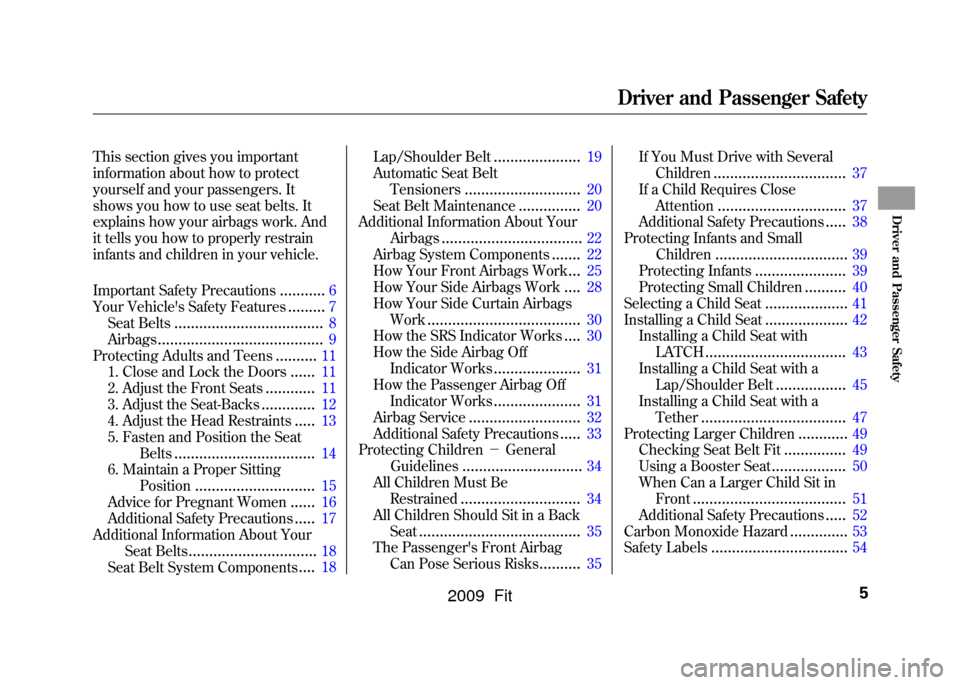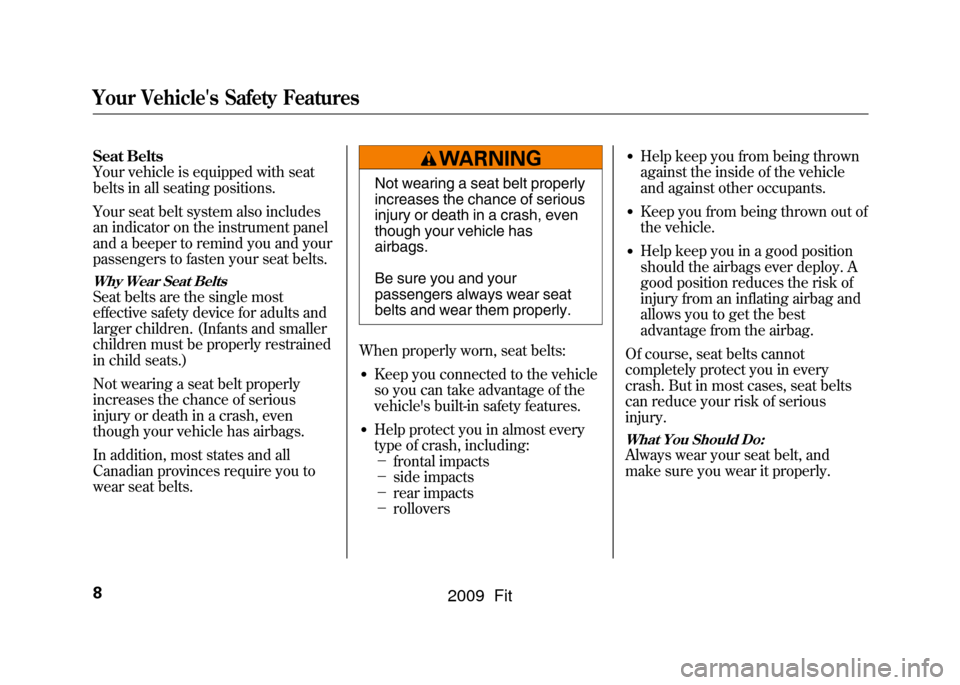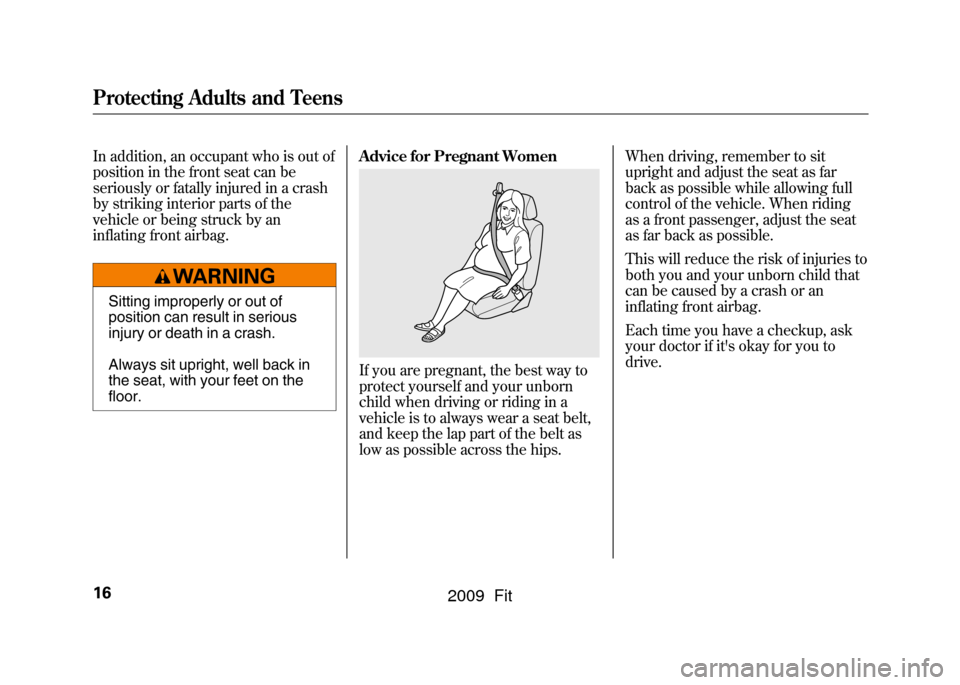2009 HONDA FIT child seat
[x] Cancel search: child seatPage 4 of 352

2009 Fit Online Reference Owner's Manual
Contents
Owner's Identification Form
Introduction .............................................................................................................................\
............................. i
A Few Words About Safety ......................................................................\
........................................................ iii
Your Vehicle at a Glance (main controls) ....................................................\
................................................ 3
Driver and Passenger Safety (seat belts, SRS, and child protection) ......................\
.............................. 5
Instruments and Controls
(indicators, gauges, dashboard, steering wheel, and other convenience items)
............. 57
Features (heating and cooling, audio, steering wheel, security, and cruise control) ................................. 109
Before Driving (fuel, vehicle break-in, and cargo loading) ...........................................\
........................... 197
Driving (engine and transmission operation) .........................................\
....................................................... 213
Maintenance (minder, fluid checking, minor services, and vehicle storage)........................................... 243
Taking Care of the Unexpected (flat tire, dead battery, overheating, and fuses) .............................. 283
Technical Information (vehicle specifications, tires, and emissions controls) ....................................... 315
Warranty and Customer Relations (U. S. and Canada only) (warranty and contact information) ... 331
Index ....................................................................................................................................\
.................................... I
Service Information Summary ( fluid capacities and tire pressures)
\
\
1 00X31-TK6-6003
Page 5 of 352

Contents
A convenient reference to the
sections in this manual.
Your Vehicle at a Glance
A quick reference to the main
controls in your vehicle.
Driver and Passenger Safety
Important information about the
proper use and care of your vehicle's
seat belts, an overview of the
supplemental restraint system, and
valuable information on how to
protect children with child restraints.
Instruments and Controls
Explains the purpose of each
instrument panel indicator and
gauge, and how to use the controls
on the dashboard and steering
column.
Features
How to operate the heating and air
conditioning system, the audio
system, and other convenience
features.Before Driving
What gasoline to use, how to break-
in your new vehicle, and how to load
luggage and other cargo.
Driving
The proper way to start the engine,
shift the transmission, and park.
Maintenance
The maintenance minder shows you
when you need to take your vehicle
to the dealer for maintenance
service. There is also a list of things
to check and instructions on how to
check them.
Taking Care of the Unexpected
This section covers several problems
motorists sometimes experience, and
details how to handle them.
Technical Information
ID numbers, dimensions, capacities,
and technical information.
Warranty and Customer Relations
(U.S. and Canada only)
A summary of the warranties
covering your new vehicle, and how
to contact us for any reason. Refer to
your warranty manual for detailed
information.
Index
Service Information Summary
A summary of the information you
need when you pull up to the fuel
pump.Overview of Contents2
2009 Fit
Page 8 of 352

This section gives you important
information about how to protect
yourself and your passengers. It
shows you how to use seat belts. It
explains how your airbags work. And
it tells you how to properly restrain
infants and children in your vehicle.
Important Safety Precautions
...........
6
Your Vehicle's Safety Features
.........
7
Seat Belts
....................................
8
Airbags
........................................
9
Protecting Adults and Teens
..........
11
1. Close and Lock the Doors
......
11
2. Adjust the Front Seats
............
11
3. Adjust the Seat-Backs
.............
12
4. Adjust the Head Restraints
.....
13
5. Fasten and Position the Seat
Belts
..................................
14
6. Maintain a Proper Sitting
Position
.............................
15
Advice for Pregnant Women
......
16
Additional Safety Precautions
.....
17
Additional Information About Your Seat Belts
...............................
18
Seat Belt System Components
....
18 Lap/Shoulder Belt
.....................
19
Automatic Seat Belt
Tensioners
............................
20
Seat Belt Maintenance
...............
20
Additional Information About Your Airbags
..................................
22
Airbag System Components
.......
22
How Your Front Airbags Work
...
25
How Your Side Airbags Work
....
28
How Your Side Curtain Airbags Work
.....................................
30
How the SRS Indicator Works
....
30
How the Side Airbag Off
Indicator Works
.....................
31
How the Passenger Airbag Off Indicator Works
.....................
31
Airbag Service
...........................
32
Additional Safety Precautions
.....
33
Protecting Children -General
Guidelines
.............................
34
All Children Must Be Restrained
.............................
34
All Children Should Sit in a Back Seat
.......................................
35
The Passenger's Front Airbag
Can Pose Serious Risks
..........
35 If You Must Drive with Several
Children
................................
37
If a Child Requires Close Attention
...............................
37
Additional Safety Precautions
.....
38
Protecting Infants and Small Children
................................
39
Protecting Infants
......................
39
Protecting Small Children
..........
40
Selecting a Child Seat
....................
41
Installing a Child Seat
....................
42
Installing a Child Seat with LATCH
..................................
43
Installing a Child Seat with a Lap/Shoulder Belt
.................
45
Installing a Child Seat with a Tether
...................................
47
Protecting Larger Children
............
49
Checking Seat Belt Fit
...............
49
Using a Booster Seat
..................
50
When Can a Larger Child Sit in Front
.....................................
51
Additional Safety Precautions
.....
52
Carbon Monoxide Hazard
..............
53
Safety Labels
.................................
54
Driver and Passenger Safety
5
Driver and Passenger Safety
2009 Fit
Page 9 of 352

You'll find many safety
recommendations throughout this
section, and throughout this manual.
The recommendations on this page
are the ones we consider to be the
most important.
Always Wear Your Seat Belt
A seat belt is your best protection in
all types of collisions. Airbags are
designed to supplement seat belts,
not replace them. So even though
your vehicle is equipped with
airbags, make sure you and your
passengers always wear your seat
belts, and wear them properly (see
page14).Restrain All Children
Children age 12 and under should
ride properly restrained in a back
seat, not the front seat. Infants and
small children should be restrained
in a child seat. Larger children
should use a booster seat and a lap/
shoulder belt until they can use the
belt properly without a booster seat
(see pages34
-52).
Be Aware of Airbag Hazards
While airbags can save lives, they
can cause serious or fatal injuries to
occupants who sit too close to them,
or are not properly restrained.
Infants, young children, and short
adults are at the greatest risk. Be
sure to follow all instructions and
warnings in this manual.
Don't Drink and DriveAlcohol and driving don't mix. Even
one drink can reduce your ability to
respond to changing conditions, and
your reaction time gets worse with
every additional drink. So don't drink
and drive, and don't let your friends
drink and drive, either.Control Your SpeedExcessive speed is a major factor in
crash injuries and deaths. Generally,
the higher the speed, the greater the
risk, but serious injuries can also occur
at lower speeds. Never drive faster
than is safe for current conditions,
regardless of the maximum speed
posted.Keep Your Vehicle in Safe ConditionHaving a tire blowout or a mechanical
failure can be extremely hazardous. To
reduce the possibility of such
problems, check your tire pressures
and condition frequently, and perform
all regularly scheduled maintenance
(see page245).
Important Safety Precautions6
2009 Fit
Page 11 of 352

Seat Belts
Your vehicle is equipped with seat
belts in all seating positions.
Your seat belt system also includes
an indicator on the instrument panel
and a beeper to remind you and your
passengers to fasten your seat belts.Why Wear Seat BeltsSeat belts are the single most
effective safety device for adults and
larger children. (Infants and smaller
children must be properly restrained
in child seats.)
Not wearing a seat belt properly
increases the chance of serious
injury or death in a crash, even
though your vehicle has airbags.
In addition, most states and all
Canadian provinces require you to
wear seat belts.
Not wearing a seat belt properly
increases the chance of serious
injury or death in a crash, even
though your vehicle has
airbags.
Be sure you and your
passengers always wear seat
belts and wear them properly.
When properly worn, seat belts:●Keep you connected to the vehicle
so you can take advantage of the
vehicle's built-in safety features.●Help protect you in almost every
type of crash, including:
- frontal impacts
- side impacts
- rear impacts
- rollovers
●Help keep you from being thrown
against the inside of the vehicle
and against other occupants.●Keep you from being thrown out of
the vehicle.●Help keep you in a good position
should the airbags ever deploy. A
good position reduces the risk of
injury from an inflating airbag and
allows you to get the best
advantage from the airbag.
Of course, seat belts cannot
completely protect you in every
crash. But in most cases, seat belts
can reduce your risk of serious
injury.
What You Should Do:Always wear your seat belt, and
make sure you wear it properly.
Your Vehicle's Safety Features8
2009 Fit
Page 14 of 352

Introduction
The following pages provide
instructions on how to properly
protect the driver, adult passengers,
and teenage children who are large
enough and mature enough to drive
or ride in the front.
See pages34-38for important
guidelines on how to properly protect
infants, small children, and larger
children who ride in your vehicle.
1. Close and Lock the Doors
After everyone has entered the
vehicle, be sure the doors and the
tailgate are closed and locked.
Your vehicle has a door and
tailgate open indicator on
the instrument panel to indicate
when any door or the tailgate is not
tightly closed.
Locking the doors reduces the
chance of someone being thrown out
of the vehicle during a crash, and it
helps prevent passengers from
accidentally opening a door and
falling out.
Locking the doors and the tailgate
also helps prevent an outsider from
unexpectedly opening a door or the
tailgate when you come to a stop.
See page81for how to lock the
doors, and page62for how the door
and tailgate open indicator works.
Some models have the auto door
locking/unlocking feature. For more
information, see page83. 2. Adjust the Front Seats
Adjust the driver's seat as far to the
rear as possible while allowing you to
maintain full control of the vehicle.
Have a front passenger adjust their
seat as far to the rear as possible.
CONTINUED
Protecting Adults and Teens
11
Driver and Passenger Safety
2009 Fit
Page 19 of 352

In addition, an occupant who is out of
position in the front seat can be
seriously or fatally injured in a crash
by striking interior parts of the
vehicle or being struck by an
inflating front airbag.
Sitting improperly or out of
position can result in serious
injury or death in a crash.
Always sit upright, well back in
the seat, with your feet on the
floor.Advice for Pregnant Women
If you are pregnant, the best way to
protect yourself and your unborn
child when driving or riding in a
vehicle is to always wear a seat belt,
and keep the lap part of the belt as
low as possible across the hips. When driving, remember to sit
upright and adjust the seat as far
back as possible while allowing full
control of the vehicle. When riding
as a front passenger, adjust the seat
as far back as possible.
This will reduce the risk of injuries to
both you and your unborn child that
can be caused by a crash or an
inflating front airbag.
Each time you have a checkup, ask
your doctor if it's okay for you to
drive.
Protecting Adults and Teens16
2009 Fit
Page 21 of 352

Seat Belt System ComponentsYour seat belt system includes lap/
shoulder belts in all seating positions.
The front seat belts are also equipped
with automatic seat belt tensioners.
This system uses the same sensors as
the front airbags to monitor whether
the front seat belts are latched or
unlatched, and how much weight is on
the front passenger's seat (see page
27).
The seat belt system includes
an indicator on the instrument
panel and a beeper to remind you and
your passengers to fasten your seat
belts.
This system monitors the front seat
belts. If you turn the ignition switch to
the ON (II) position before your seat
belt is fastened, the beeper will sound
and the indicator will flash. If your seat
belt is not fastened before the beeper
stops, the indicator will stop flashing
but remain on.
If a front passenger does not fasten
their seat belt, the indicator will
come on about 6 seconds after the
ignition switch is turned to the ON
(II) position.
If either the driver or a front
passenger does not fasten their seat
belt while driving, the beeper will
sound and the indicator will flash
again at regular intervals.
When no one is sitting in the front
passenger's seat, or a child or small
adult is riding there, the indicator
should not come on and the beeper
should not sound. If the indicator comes on or the
beeper sounds when the driver's seat
belt is latched and there is no front
seat passenger and no items on the
front seat, something may be
interfering with the monitoring
system. Look for and remove:
●Any items under the front
passenger's seat.●Any object(s) hanging on the seat
or in the seat-back pocket.●Any object(s) touching the rear of
the seat-back.
If no obstructions are found, have
your vehicle checked by a dealer.
Additional Information About Your Seat Belts18
2009 Fit